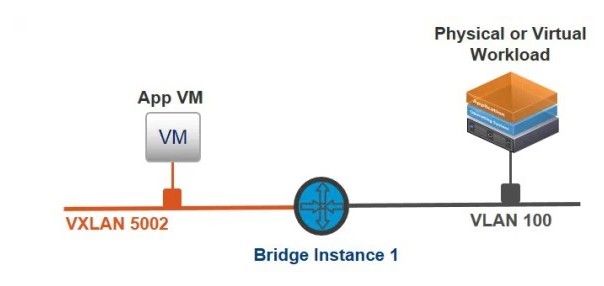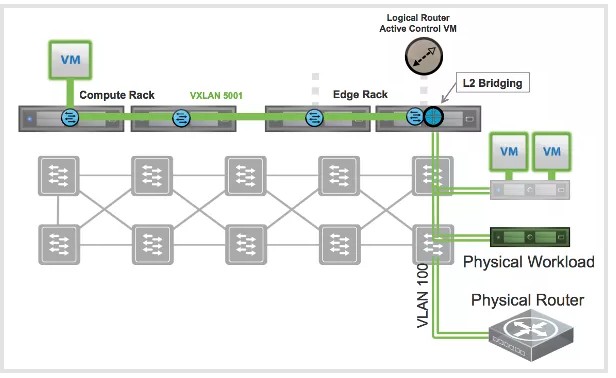If these port groups are VXLAN based, then for each of the port groups a Logical Switch should exist. For each VXLAN there is a VNI Number similar to Vlan-Id on the physical switches.
VM web - 192.168.10.10 --> VNI 5010 - LS-Web
VM app - 192.168.20.10 -->VNI 5020 LS-App
VM db - 192.168.30.10 --> VNI 5030 LS-DB
Physical web - 192.168.10.11 --> Vlan 10 - Port Group PG-Web
Physical app - 192.168.20.11 -->Vlan 20 - Port Group PG-App
Physical db - 192.168.30.11--> Vlan 30 - Port Group PG-DB
Since both Physical Web and VM Web are on the same IP Subnet, there should be a bridge (similar to a virtual connection) between Vlan 10 and VNI 5010. NSX Uses DLR bridge Mode Feature for this Purpose. The ESXi host where the DLR Control VM exists act as a bridge between those VMs. If you try to ping 192.168.10.11 from the Web-VM the packet will:
1. Go th the ESXi host of the Bridge through a VXLAN Tunnel
2. --> pass through the bridge
3. --> Physical Uplink of ESXi host that DLR Control VM Resides
4. --> Pysical Switch(es) --> Physical Web Server.

These articles may be helpful for more detailed configuration and design:
http://www.routetocloud.com/2014/10/nsx-l2-bridging/
http://planetvm.net/blog/?p=2905

VLAN/VXLAN "bridging". To DLR or not?
( Bridged DLR may act as router and bridge at the same time)
http://chansblog.com/tag/nsx-l2-bridge/
In general Bridged DLR is used for cases such as P-V Conversion of Machines, and if there are devices such as Physical Firewall or a Physical Load Balancer that serves this Logical Switch, or a Server that is not possible (preferred to remain physical) to be virtualized, then it may be recommended to change the IP address for Physical or Virtual side and use bridge functionality as an intermediate solution. For L3 Underlay Physical Fabric Designs, each Vlan (since it may be considered as a failure domain due to STP) is considered to local only on the TOR switch. This is because the Vlans for each VM and Physical Machines exist on same subnet should be extended through the Data Center. So if not needed it may be better to use a routed design instead of bridging.